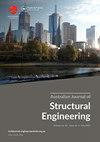利用遗产建筑记录来描述澳大利亚布里斯班的无加固砖石建筑
IF 1.3
Q4 ENGINEERING, CIVIL
Australian Journal of Structural Engineering
Pub Date : 2022-08-24
DOI:10.1080/13287982.2022.2112286
引用次数: 0
摘要
在世界范围内,无加固砌体(URM)建筑大量存在,其中许多具有文化和遗产价值。URM建筑在过去的地震中表现不佳的历史是众所周知的,因为它们的抗拉性能较弱,而且构件之间缺乏机械连接。关于一个地区URM建筑建设的信息很重要,因为它可以帮助工程师和决策者进行地震评估、风险和损失研究。在这方面,本研究包括使用昆士兰遗产登记册(QHR)对澳大利亚布里斯班市及其周边郊区的传统URM建筑进行特征描述。QHR包括1775个遗产遗址,其中323个被确定为布里斯班市及其周边郊区的URM建筑。从QHR获得的研究建筑特征包括建筑风格、建造年份、功能/用途、层数、屋顶材料和承重墙材料。其他特征,如屋顶类型(形状)、平面几何形状、孤立或相互连接的建筑物、阳台和开口,以及山墙、烟囱和护墙等地震危险的存在,都是通过在线3D地图获得的。研究的结论是,结合在线数字资源,可以成功地利用文物登记册来描述URM建筑的特征。本文章由计算机程序翻译,如有差异,请以英文原文为准。
Using heritage building registers to characterise unreinforced masonry buildings of Brisbane, Australia
ABSTRACT Worldwide, unreinforced masonry (URM) buildings are present in abundance with many holding cultural and heritage value. URM buildings have a known history of poor performance during past earthquakes because of the weak tensile properties and lack of mechanical connections between elements. Information about the construction of URM buildings for a region is important because it can help engineers and policy makers to perform seismic assessment, risk and loss studies. In this regard, this study includes a characterisation of the heritage URM buildings in Brisbane City, Australia, and its surrounding suburbs using the Queensland Heritage Register (QHR). The QHR includes a total of 1775 heritage sites, of which 323 are identified as URM buildings in Brisbane City and surrounding suburbs. The studied building characteristics obtained from QHR included the architectural styles, construction year, function/use, number of storeys, roof material and load-bearing wall materials. Other features such as roof types (shapes), plan geometry, isolated or interconnected buildings, verandas and openings, and finally the presence of seismic hazards such as gable-end walls, chimneys, and parapets have been obtained using online 3D maps. It was concluded that heritage registers in combination with online digital resources can be successfully utilised to characterise URM buildings.
求助全文
通过发布文献求助,成功后即可免费获取论文全文。
去求助
来源期刊

Australian Journal of Structural Engineering
ENGINEERING, CIVIL-
CiteScore
2.50
自引率
0.00%
发文量
31
期刊介绍:
The Australian Journal of Structural Engineering (AJSE) is published under the auspices of the Structural College Board of Engineers Australia. It fulfils part of the Board''s mission for Continuing Professional Development. The journal also offers a means for exchange and interaction of scientific and professional issues and technical developments. The journal is open to members and non-members of Engineers Australia. Original papers on research and development (Technical Papers) and professional matters and achievements (Professional Papers) in all areas relevant to the science, art and practice of structural engineering are considered for possible publication. All papers and technical notes are peer-reviewed. The fundamental criterion for acceptance for publication is the intellectual and professional value of the contribution. Occasionally, papers previously published in essentially the same form elsewhere may be considered for publication. In this case acknowledgement to prior publication must be included in a footnote on page one of the manuscript. These papers are peer-reviewed as new submissions. The length of acceptable contributions typically should not exceed 4,000 to 5,000 word equivalents. Longer manuscripts may be considered at the discretion of the Editor. Technical Notes typically should not exceed about 1,000 word equivalents. Discussions on a Paper or Note published in the AJSE are welcomed. Discussions must address significant matters related to the content of a Paper or Technical Note and may include supplementary and critical comments and questions regarding content.
 求助内容:
求助内容: 应助结果提醒方式:
应助结果提醒方式:


